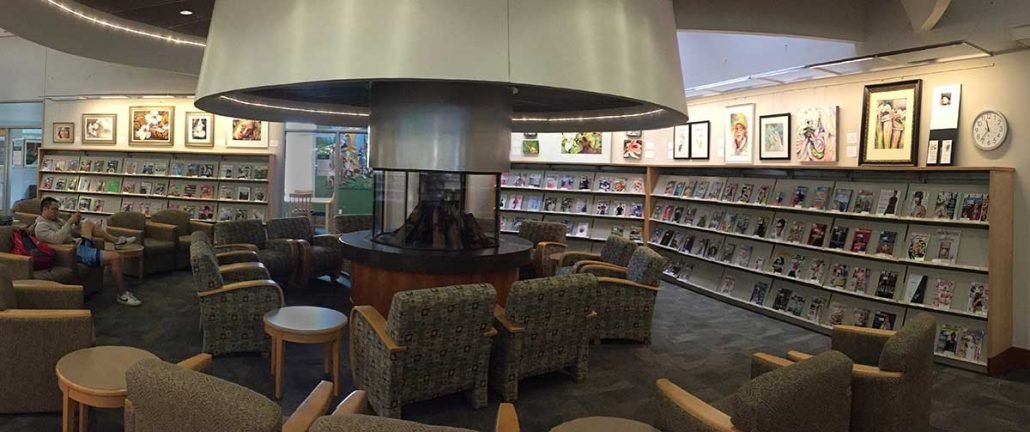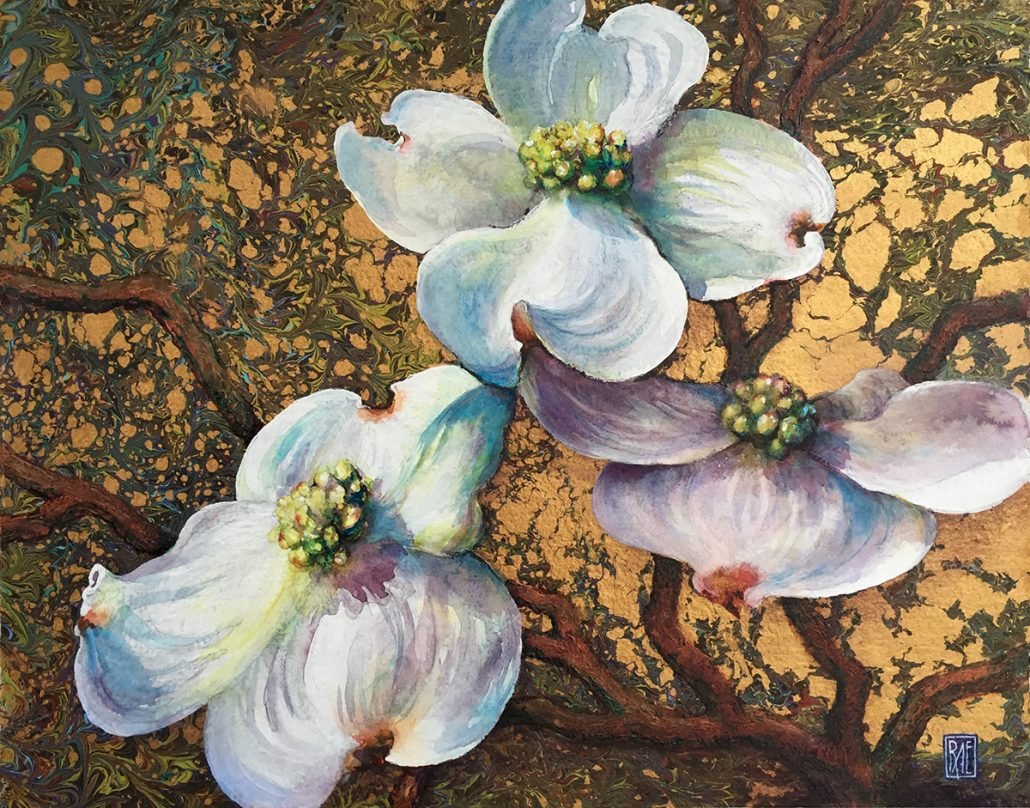EXPERIENCING ART WITH RENE EISENBART:
An Interview with the Artist
By Angela Wrahtz
Our community will have an exciting opportunity to experience the art of Rene Eisenbart which goes on display in the Living Room Gallery at the Tualatin Public Library this July and running through mid-September. Formerly an artist for the Oregonian, Rene Eisenbart painted hundreds of botanicals for their Homes & Gardens section which led to publication of the illustrated botanical book “Plant This!” Now Rene paints at her studio in the Tualatin Mountains Northwest of Portland. She has developed a technique for combining acrylic marbling with watercolor painting to create unique and compelling, expressive works of art. Drawing inspiration from familiar plants and creatures, or from the human form, her colorful watercolor images are often woven with marbled patterning or integrated over textured acrylic. She uses dramatic color and design to move the eye through her paintings. These paintings, interlaced with deeper symbolic meaning, invite the viewer to construct their own narrative.
EPIC ISLAND III
DOGWOOD ON GOLD
PONDERING
LOVE BIRDS
Here begins an interview with René, who is a signature member of the National Watercolor Society and Western Federation Watercolor Society and has won numerous awards.
I have met endless numbers of people over the years who have cut your illustrations out of the paper and saved them. How does it feel to be a celebrity?
Pretty amazing! It’s not that my work was so special, but having it continually published was a fabulous opportunity that has connected me with others. The experience has been extraordinary.
With the newspaper falling on hard financial times, was it difficult to leave a successful career in journalism art?
No. I miss the people, but not the job. It was a gift to have been able to touch so many through my art and I will always be grateful. It gave me name recognition. But now, I find the opportunity to direct my own path and indulge my passion for teaching and painting an incredible luxury. I’ve spent my whole life preparing for this. When I was younger, I believed that my best years would be my later years, and now that has come to pass! I love my life, even though I’m working harder than ever.
What led you to become an artist?
The creative process is intensely exhilarating! Art is a very personal expression. There is a huge amount of freedom in this. I absolutely love being “in the zone” of creation— the energy is palpable. Creating is what makes me feel truly alive. As a child I loved to paint and draw and discovered my mind will easily visualize and problem-solve, both skills being conducive to art making.
What inspires your art?
Each of my paintings has a story in it. For some, the inspiration comes from exploring my own back yard. Other paintings are born of exposure to the world around. Many take root from an image I see and capture digitally. All these images were defined by a moment in time that resonated with me! Remove an event from my life and that painting is gone. Without the experience the art would not exist.
Your work covers a broad range in subject matter and technique — botanical, portrait, marbled, collage. Would you say you have a particular goal?
Yes! I don’t want to be predictable or boring. Maybe that’s why I keep experimenting and trying new technique. Who I am determines the marks I make and each painting has my hand in it quite literally. While my subject matter is diverse, the body of work is cohesive, even with variety of style.
How would you describe your painting strategy?
I might be thinking about a painting for years before I ever have a chance to paint it. Working loose at the beginning — throwing paint around or letting it puddle — allows the painting to evolve. I want to let the flowing paint speak. It directs where the painting needs to go and I listen. Watercolor has a reputation for being a difficult medium, but it’s actually very easy to control when you know how. The trick is to allow the paint to do what it does and respond to that. The resulting texture is often more beautiful than anything I could impose. I am careful to encourage and leave the blossoms and drips. It’s the “imperfections” that make my work unique. Art is in knowing what to keep and what to change.
Your fine art marbling technique is highly innovative. What led you to use marbling with your painting?
I have always loved patterning. I took a one-day marbling workshop from Galen Berry from Oklahoma, a master of marbling technique. It seemed so difficult, then I learned it was actually simple if you follow a few steps. But I didn’t expect it to become a dominant element in my painting. I began experimenting with marbling over paintings. I had no idea what I was doing but learned a lot in the process! Most of my early attempts were failures, and I learned from that how to do it successfully. I love how the marbled patterning creates a mystique when combined with a painting.
You even incorporate marbling into portraits…very cool. Unlike others who paint literal portraits, yours are broader and highly expressive of the individual’s spirit. The hardest critics of a portrait, perhaps, are those memorialized in them. One subject of yours once exclaimed: “Stunning. How well you brought alive an emotional life. Really amazing!” What draws you to painting portraits?
I’m totally enamored with the human form. In my portraits, my goal is to capture the essence of a person, not just a likeness.
How do you know when a painting is finished?
When I can’t find a way to improve it! Sometimes the smallest changes can make a huge difference in the success of a piece. In the beginning, the painting happens quickly. I spend the majority of my time finishing that last 10 percent, carefully considering my moves.
How did your distinctive signature “chop” come about?
One of my art groups suggested creating signature icons. Years ago when signatures were not allowed at the Oregonian I had used stylized initials to identify my artwork. So I put those initials inside a border and carved a stamp of it. I like the way it integrates into the design of my work so well that I’m using the chop as signature on most of my paintings.
To what do you attribute your artistic success?
Several things really. I work constantly, so a good work ethic helps. I’m willing to try about anything, and occasionally I get lucky! My stubbornness — I’ll call it tenacity — is an asset. I rarely allow myself to give up on a painting. That goes hand in hand with optimism. It’s useful to have the vision to see the potential in a painting that is still half baked. Then, there’s risk taking. I experiment, pushing myself out of the comfort zone, allowing myself to make lots of mistakes. That’s how I grow. Learning to make good art is really knowing how to fix bad art — paying attention to what works, and why.
You just recently returned from an art trip to Croatia. How did your “Experience Art” travel workshops come about?
I’d always looked forward to travel and now I’ve made that happen by providing the experience to others. One thing just led to another. While this can be the most difficult and demanding of all my pursuits, it is also incredibly rewarding. I’ve formed many lifelong connections and have learned so much in the process. Artists really do make the best travel companions and these experiences continue to inform the art I make.
What advice do you have for Artists starting out?
Painting is a learned skill. Take baby steps. Don’t expect it all to happen for you immediately. Figure out where your genius is and capitalize on it. Walk in the direction of your goals and you’ll get there eventually.
Finally, what are your art goals now?
For projects, currently I am working on a commissioned painting of rhododendron and trillium blossoms on a 50×40 inch wood panel, and I will teach a 3-day marbling and collage workshop at Emerald Art Center in Springfield July 27, 28 and 29.
Regarding personal development, I like to push the envelope and do the unexpected. My challenge is to keep improving. I can always imagine beyond my ability to create, so I’m continually reaching. Though I want my work to hold the viewer’s attention, I paint to please myself and not my subject or audience. It’s important to listen to my own voice. To pay attention to what resonates with me. I want to take my images and evolve them into something else to evoke a feeling, always interpreting. I think that is where my work is going.

Art on display may be purchased by contacting the City of Tualatin. To learn more about the Living Room Gallery program at the Tualatin Library, contact Coordinator/Gallerist Angela Wrahtz at angela.wrahtz@comcast.net. This program is sponsored in part by the Tualatin Arts Advisory Committee.
Rene teaches in her studio and throughout the Northwest as well as leading workshops in Croatia, Kauai, Tuscany and Provence. She encourages each person’s unique artistic expression, creating a safe, supportive environment for growth and experimentation. Read more about her process on her blog






